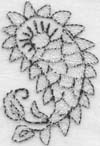Section 4 == *script chart*; *positional chart*; *more help*
4.1 == The letters sīn
and shīn
The letter sīn is the standard "s," the one you'd use as the "least marked" form for ordinary purposes. It has two forms, which we might call "smooth" and "bumpy." One or the other is chosen mostly for esthetic reasons, to make a better effect in certain connected environments. The initial and medial forms consist of only the first part of the letter (either a smooth or a bumpy shallow curve), without the large round shape that follows them in the independent form. When a bumpy sīn is followed by a member of the re series, its final little bump merges into the re series letter and is lost to view.
The letter shīn consists of a sīn , either smooth or bumpy, with three dots in a triangular shape above it. It sounds like "sh." It is used for all "sh" sounds, including the Devanagari retroflex "Sha" (as in uShaa) which is not separately shown in Urdu script.
The letter ṣvād is pronounced "s." In initial and medial forms it is distinguished by its large and relatively flat loop followed by one bump (except when the next letter is a member of the re series, in which case the bump merges into the next letter and becomes almost invisible). Its final form looks just like its independent form.
Of the three "s" letters in Urduu, sīn is much the most common and is the one to be preferred when in doubt. The letter ṣvād occurs only in certain Arabic words. The rarest, the letter ṡe , occurs in a very few Arabic words only. Neither should ever be used for words of Indic or Western origin. In Arabic, ṡe is pronounced "the"; thus anecdotes about the Prophet are called hadīṡ in Urdu, while the same word is pronounced "hadiith" in Arabic. Remember that the spelling remains identical, and only the pronunciation changes.
The letter ẓvād is ṣvād with a dot over it. It is pronounced "z." It is the third of the four "z"-sounding letters in the Urdu script. It occurs only in words of Arabic origin. In Arabic, it is pronounced as a kind of dental "d." Thus the holiday that is pronounced ramẓān in Urdu is pronounced as "Ramadaan" in Arabic. Remember that the spelling remains identical, and only the pronunciation changes.
The letter t̤oʾe looks like a large version of the retroflex marker. This is irrelevant; don’t let it confuse you. The letter t̤oʾe has the delightful and user-friendly feature that its independent, initial, medial, and final forms are all identical: it is the only connector that doesn't ever change its shape. The letter t̤oʾe is pronounced as a dental "t," exactly like te in the be series. It is used only in certain Arabic words; for all other uses, te is preferred.
The letter z̤oʾe is simply t̤oʾe with a dot above it. All the things that are true of t̤oʾe , except pronunciation, are true of it as well. It has the sound of "z," and occurs in certain Arabic words.
We now have seen all four of the Urdu letters that sound like "z": to take them in dictionary order, they are żāl , ze , ẓvād , and :zo))e . Remember that ze is the normal or "least marked" choice, to be used for English words like "zoo." It should also be used when you truly haven't a clue which fancy "z" letter should go into a particular word, because a too-simple spelling looks less absurd than an incorrect fancy spelling.
The other three "z" letters, apart from ze , come built into certain Arabic words, and occur only there; they must be memorized as part of the spelling of each word. This is an excellent reason to learn to recognize the most important Arabic roots of common Urdu words. All this is a bother compared to Devanagari, but still not nearly so bothersome as English spelling. All these "z" letters are rendered in Devanagari as a "ja" with a dot under it.
